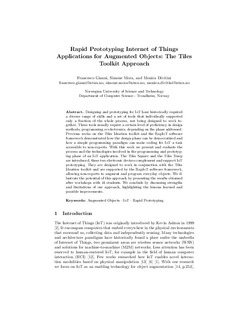Rapid prototyping internet of things applications for augmented objects: The tiles toolkit approach
Journal article, Peer reviewed
Accepted version

Åpne
Permanent lenke
http://hdl.handle.net/11250/2590468Utgivelsesdato
2018Metadata
Vis full innførselSamlinger
Originalversjon
Lecture Notes in Computer Science. 2018, 11249 LNCS 204-220. 10.1007/978-3-030-03062-9_16Sammendrag
Designing and prototyping for IoT have historically required a diverse range of skills and a set of tools that individually supported only a fraction of the whole process, not being designed to work together. These tools usually require a certain level of proficiency in design methods, programming or electronics, depending on the phase addressed. Previous works on the Tiles Ideation toolkit and the RapIoT software framework demonstrated how the design phase can be democratized and how a simple programming paradigm can make coding for IoT a task accessible to non-experts. With this work we present and evaluate the process and the technologies involved in the programming and prototyping phase of an IoT application. The Tiles Square and the Tiles Temp are introduced, these two electronic devices complement and support IoT prototyping. They are designed to work in conjunction with the Tiles Ideation toolkit and are supported by the RapIoT software framework, allowing non-experts to augment and program everyday objects. We illustrate the potential of this approach by presenting the results obtained after workshops with 44 students. We conclude by discussing strengths and limitations of our approach, highlighting the lessons learned and possible improvements.